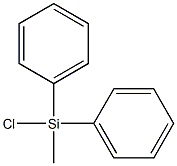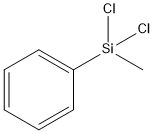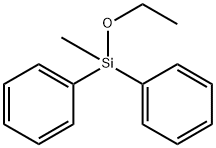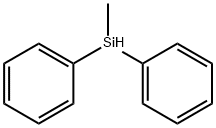
Chlorodiphenylmethylsilane synthesis
- Product Name:Chlorodiphenylmethylsilane
- CAS Number:144-79-6
- Molecular formula:C13H13ClSi
- Molecular Weight:232.78

75-79-6
293 suppliers
$15.00/5 g

100-59-4
271 suppliers
$38.00/0.25mole

108-90-7
685 suppliers
$10.00/25G

149-74-6
176 suppliers
$14.14/5gm:

144-79-6
176 suppliers
$20.00/5g
Yield:144-79-6 94.11%
Reaction Conditions:
in diethyl ether at 67; for 0.166667 h;Product distribution / selectivity;Grignard Reaction;
Steps:
2
[0028] In this example, the coupling mole ratio was 1/4/3/1. 3/0. 38 of phenylmagnesium chloride/diethyl ether/chlorobenzene/methyltrichlorosilane/phenylmethyldichlorosilane (PhMgCl/Et20/C6H5Cl/MeSiCl3/PhMeSiCl2). The MeSiCl3 and the Grignard solution (PhMgCl/Et20) used in this example were compositions prepared by an in-house facility. The mole ratio of the Grignard solution was 1/4 PhMgCl/Et2O with a PhMgCl concentration of 2 mol/L. This Grignard solution contained two phases, a liquid phase and a solids phase that settled at the bottom. Both the liquid phase and the solid phase were used in this example. Approximately 250 milliliter of the Grignard solution were transferred to a 500 milliliter addition funnel by means of a pump. The amount of Grignard solution used was the equivalent of about 0.500 mol of PhMgCl and 2.000 mol of Et2O. Then, 99. 41 gram (0.67 mol) of MeSiCl3, 36. 32 gram (0. 19 mol) of PhMeSiCl2, and 168.75 gram (1. 499 mol) of PhCl were added to a 1000 milliliter round bottom flask. [0029] The addition funnel was connected to a source of nitrogen to provide an inert atmosphere for the system and placed on a 500 milliliter three-neck round bottom flask containing a magnetic stirrer. The 500 milliliter three-neck round bottom was charged with the Grignard solution and stirred. From the 500 milliliter three-neck round bottom flask, the Grignard solution was pumped into a reactor. Addition of the Grignard solution took place over a time period of about ten minutes. The solution turned dark orange brown in color but remained in a flowable state throughout the procedure. The maximum exothermic temperature reached was 67 °C. When the agitation was stopped, the settling of solids began almost immediately. The reaction mixture was allowed to cool and then it was transferred to a labeled sample jar. The percent mass recovery was determined to be about 94. 11 percent. [0030] Gas Chromatography (GC) analysis of the reaction mixture showed that it contained about 2.9 weight percent of the desired component Ph2MeSiCl, and about 29.7 weight percent of PhMeSiC12. In this co-coupling method, the weight ratio of PhMeSiCl2/Ph2MeSiCl was 0. 1.
References:
DOW CORNING CORPORATION WO2005/68476, 2005, A1 Location in patent:Page/Page column 7

1825-59-8
132 suppliers
$16.00/250mg

144-79-6
176 suppliers
$20.00/5g

776-76-1
121 suppliers
$10.00/1g

144-79-6
176 suppliers
$20.00/5g

100-59-4
271 suppliers
$38.00/0.25mole

108-90-7
685 suppliers
$10.00/25G

149-74-6
176 suppliers
$14.14/5gm:

144-79-6
176 suppliers
$20.00/5g